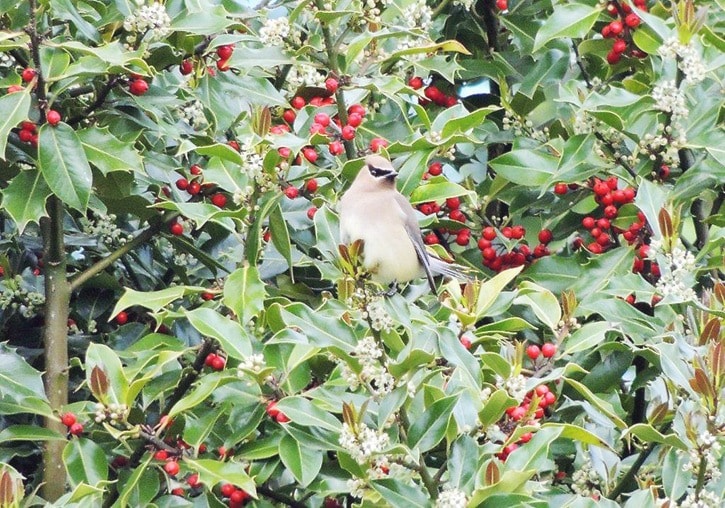Wrens are singing and the sun shines in my eyes. The daffodils are in a holding pattern — they burst through the soil about a month ago, then froze before beginning to inch up again. A single Cedar Waxwing flits from the cotoneaster bush up to the high alder.
It’s alone, but waxwings often travel in large flocks, depending on the circumstances. When visiting Smithers a few winters back, thousands of Bohemian Waxwings flew like tiny colourful jet-fighters and ate every Mountain Ash berry they could find. They often travel quietly, emitting only a gentle, high-pitched ‘seee’ as they move through the air. Cedar Waxwings are one of the prettiest birds. They have a black face mask, rusty crest, and yellow underparts. Their tails are tipped with yellow.
Cedar Waxwings don’t usually occur here in winter. Bohemian Waxwings are more likely to appear, they are a little bigger and have rusty undertail coverts. Once they find a friendly berry bush, they’ll stick with it until all the berries have been eaten.
Cats are their greatest menace. Hunting by domestic cats is one of the major threats to birds and small wildlife and is contributing to the decline of birds in Canada. Environment Canada estimates that cats kill 100 million to 350 million birds every year in Canada, many of them nestlings. Cat kills are the highest human-related source of bird deaths in the country. It’s insane to allow your cat to roam outdoors. We don’t have that many nesting birds on Haida Gwaii and the combination of habitat loss through forestry, rat poison and cat kills are doing our birds in.
“Oh yeah,” people say. “But cats are natural, they are doing their natural thing.”
Yes they are doing their natural thing, but they are not native to Haida Gwaii. In fact, they are at the top of the introduced species list that is having a profound effect on birds and small mammals. Funds can be found to deal with introduced species like raccoons or deer on offshore islands, but nothing is done to curtail the damage done by domestic cats. The Stewardship Centre for BC’s website has lots of helpful information on keeping cats happy indoors while keeping wild birds safe outdoors.
Pacific Wrens are singing. American Robins are appearing. They are a deeper red that the ones that survived here all winter. Usually, around Feb. 23, flocks of migratory robins begin to appear. They show up on lawns and meadows hopping from place to place as they feed. Thankfully the ground is not frozen as it was a few weeks ago so they are finding high-protein insects. Nature is the great and only provider and berries and insects are put there for them.
Speaking of great providers, Wayne Nelson, who studied Peregrine Falcons at Langara Island for over 35 years, calls them just that. Falcons provide for many other birds and their catch is often stolen by Bald Eagles. We were the recipients of one falcons’ meals this week when we found the remains of a Green-winged Teal on our ramp leading to the house. It gave us a close-up of the teal’s lovely green and red plumage. It was Valentine’s Day, maybe the falcon had left us a present. It seems to like the the standing trees around the house. Hope you had a good one.
hecatebird@gmail.com
